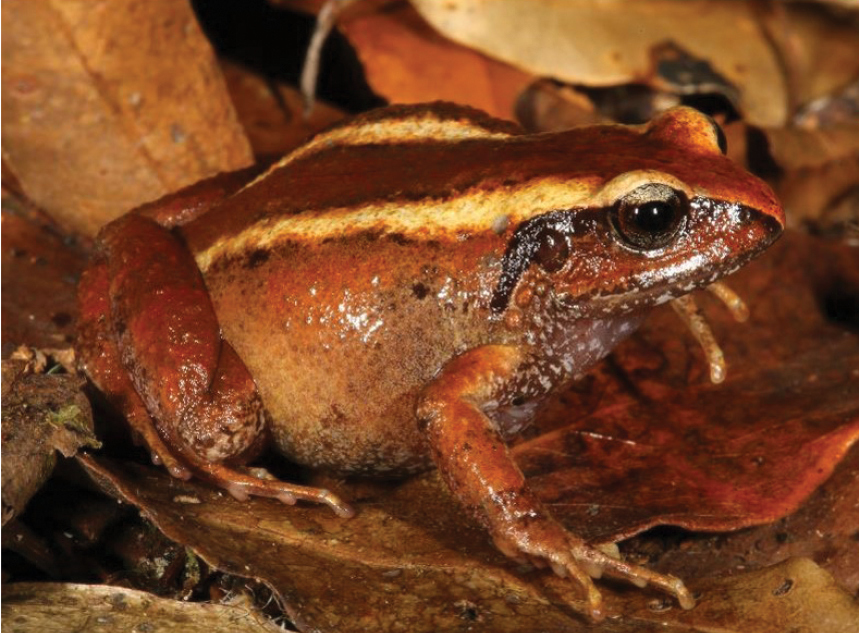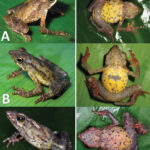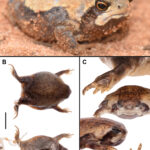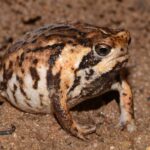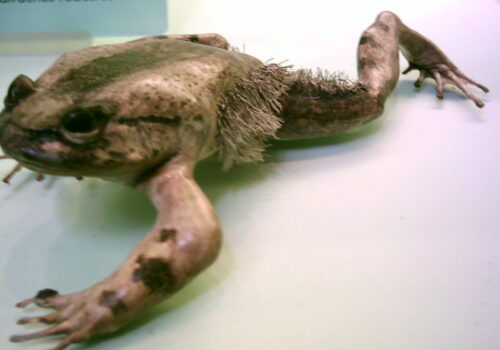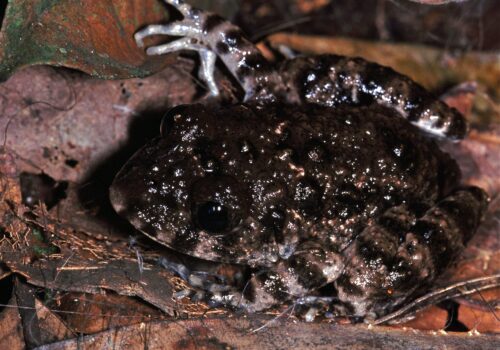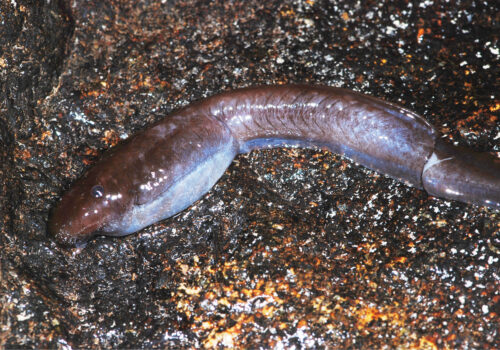Discovering Arthroleptis francei: Africa’s Secretive Forest-dwelling Frog#
In the dimly lit undergrowth of East Africa’s lush mountain forests, among moss-covered stones and leaf-strewn floors, lurks a small, enigmatic amphibian known as Arthroleptis francei. Known for its subtle grace and secretive nature, this endemic frog species has managed, for decades, to enthrall biologists and ecologists alike. This elusive creature has adapted beautifully to its specialized habitat, hidden away from casual observation, only visible to those patient enough to witness its quiet yet fascinating existence.
Arthroleptis francei, commonly referred to as France’s Screeching Frog or simply France’s Arthroleptis, is a member of the Arthroleptidae family—a group of unique frogs known for their direct developmental stage, meaning that they bypass the tadpole phase altogether. Found primarily in Tanzania and neighboring regions, this small amphibian plays a large role in maintaining the careful balance of its unique ecosystem.
Taxonomy and Classification#
Classifying wildlife accurately is critical for conservation and ecological understanding. Within scientific taxonomy, Arthroleptis francei belongs to the family Arthroleptidae. This family, part of the larger order Anura—commonly known as frogs and toads—is characterized by its fascinating reproductive strategy and terrestrial lifestyle.
The genus Arthroleptis, home to several similar forest-dwelling species, embodies frogs perfectly adapted to life on the forest floor, needing minimal direct interaction with water bodies due to their direct-developing eggs. Named in honor of renowned British zoologist R.S. France, A. francei stands out as an emblematic representative of this genus and family, reflecting key ecological and evolutionary traits distinctive to the Arthroleptidae lineage.
Natural Habitat#
Geographical Range and Distribution#
Arthroleptis francei calls Tanzania’s mountainous regions home, particularly thriving in the Eastern Arc Mountains—a biodiversity hotspot recognized globally for its rich concentration of endemic wildlife. It specifically prefers damp, shaded habitats, such as montane and sub-montane forests where moisture accumulates among fallen leaves, decaying branches, and dense vegetation.
Habitat Preferences and Adaptations#
In these secluded territories, the climate is cool and damp, and the forest floors are soft and spongy, blanketed in leaves enriched by years of decomposition. Amid this thick carpet of decay and regeneration, A. francei finds shelter, food, and ideal conditions for reproduction. With minimal dependence on standing water, this frog cleverly utilizes moist microhabitats, choosing few square meters of leaf litter as their entire world.
The frog’s choice of hiding places is not accidental but carefully attuned to the seasonal fluctuations of rainfall and humidity. Its habitat requirements underscore the intricate interconnectedness between wildlife survival and habitat preservation, emphasizing the fragility of such highly specialized ecosystems.
Physical Characteristics#
Small in stature, rarely exceeding 3 cm long, Arthroleptis francei exemplifies the evolutionary efficiency of forest-floor adaptation. Its delicate frame is complemented by coloration patterns ranging from rich browns and muted tans to olive greens and dark grays, perfectly mimicking the forest litter environment to which it is so intimately bound.
Fine speckling or subtle banding often adorn its skin, creating an effective natural camouflage. Unlike the vivid colors often associated with poisonous frogs elsewhere, A. francei’s muted hues enable stealth and concealment—vital tools for evading predators and ambushing prey unnoticed.
The texture of its skin further enhances its cryptic lifestyle. Slightly granular and matte, it mimics perfectly the textures of bark fragments, leaves, and soil. Large eyes, suited to dim, understory conditions, offer excellent vision in low-light habitats. Its slender, agile limbs enable swift escape maneuvers through tangled undergrowth, serving to evade predators like birds, snakes, and small mammals.
Behavior and Life Cycle#
Foraging Habits and Diet#
Arthroleptis francei is a diligent predator, tirelessly patrolling its modest territory in search of small invertebrates. Primarily insectivorous, it feeds predominantly on ants, termites, beetles, small spiders, and other tiny arthropods that roam the leaf-littered ground. Using keen eyesight and acute hearing, the frog employs swift, precise lunges to capture prey, a testament to its impressive hunting prowess despite its diminutive size.
Mating Rituals and Reproduction#
Unlike many frog species that require water bodies for reproduction, A. francei demonstrates specialized reproductive behavior shaped by its terrestrial existence. Rather than releasing eggs into water, females lay small clutches of eggs within moist leaf litter. Embryos develop directly from egg to miniature froglet stage—rendering an aquatic tadpole phase unnecessary. This remarkable adaptation reduces dependency on potentially volatile water sources, giving the species greater resilience in its forest environment.
The mating period often coincides with rainfall seasons when increased moisture ensures offspring survival. A chorus of male frogs emerges in the cool evening air, producing calls that, while soft and insect-like, are audible enough to lure receptive females. These soft, repetitive chirps weave into the nightly symphony of the forest, drawing keen listeners and scientists eager to locate this shy amphibian.
Ecological Role#
Within the rich tapestry of the East African mountain forest ecosystem, Arthroleptis francei occupies a crucial ecological niche as both predator and prey. By controlling populations of tiny invertebrates, this frog species prevents insect overpopulation and thus contributes to a balanced forest ecology essential to vegetation health and regeneration.
Conversely, as part of the staple diet of certain small mammalian and avian predators, France’s Screeching Frog functions as an indispensable link in higher trophic relationships. Their presence, population strength, and behavior serve ecologists as indicators of overall forest ecosystem health, marking the frog as a sentinel species whose fluctuations can reflect broader environmental dynamics.
Threats and Conservation Status#
Despite their ecological significance, Arthroleptis francei populations have gradually declined according to scientist observations. The International Union for Conservation of Nature (IUCN) lists the species as Vulnerable, with habitat loss, deforestation, and fragmentation posing significant threats. Agricultural expansion, logging, and encroachment into their habitats represent considerable pressures, resulting in shrinking and increasingly isolated frog populations.
Climate change exacerbates habitat threats, altering rainfall patterns and temperatures vital to their specialized reproduction strategy. Moreover, disease transmission such as chytrid fungus (Bd) has emerged as an additional threat with devastating implications elsewhere in global amphibian populations.
Thankfully, efforts to stem these threats have emerged locally and internationally. Conservationists and scientists are establishing protected forest reserves, sustainably managing existing habitats, and conducting research projects to better understand and preserve the delicate balance vital to A. francei survival. Ongoing advocacy for preserving Tanzania’s precious forests offers promise and hope for this exquisite but threatened amphibian.
Cultural and Scientific Significance#
Though perhaps less iconic worldwide than many flagship species, frogs like Arthroleptis francei embody deep cultural and ecological significance within communities dwelling near forested regions. Indigenous locals recognize frogs as rain messengers, symbols of fertility, and vital indicators of a healthy environment. Scientific recognition equally acknowledges this frog’s potential as a bioindicator species instrumental in studying forest health, climatic changes, and the intricate mechanics of ecosystem resilience and regeneration.
Conclusion#
Through patience and study, the wonders of Arthroleptis francei reveal themselves—their unique behaviors, subtle beauty, and critical ecological roles. Yet their existence hangs precariously by threads of habitat integrity, careful conservation, and public awareness. In safeguarding forests and frogs, we also secure the wider umbrella of biodiversity flourishing alongside them.
Let the compelling story of France’s Screeching Frog remind us all of nature’s interwoven magnificence and inspire us toward conservation stewardship. As advocates, educators, students, or simply enthusiasts of nature, our collective awareness and action become cornerstones of preservation. Consider supporting amphibian conservation initiatives, sharing this knowledge, or simply exploring further into the vibrant life hidden within our planet’s forests.




